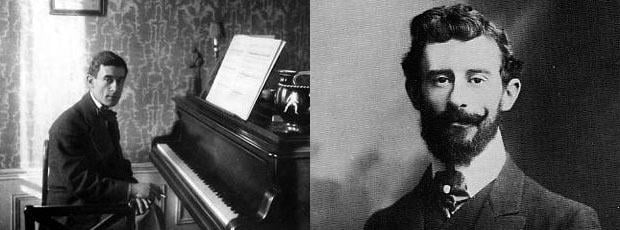In early 20th-century France, Ravel was one of the great orchestrators in music. He used his original harmonic sensibility to create lush, tuneful, and engaging works.
Vital Statistics
Born:
March 7, 1875, in Ciboure, France
Died:
December 23, 1937, in Paris, of Pick’s disease
During Lifetime:
Eiffel Tower unveiled, 1887-89. Impressionist movement in paintings takes hold; Paris becomes the international center of the artistic avant-garde.
Biographical Outline
Rejecting authority : Ravel was dismissed from his Paris Conservatoire classes in 1895. He returned two years later to study composition with Gabriel Fauré, but was dismissed again in 1900.L’affaire Ravel :Jeux d’Eau (Play of water) and his string quartet.Avant-garde circles, 1902 : He became part of the artistic discussion group known as “Les Apaches” (The ruffians), which included the Spanish composer Manuel de Falla and the poet Tristan Klingsor, among others. A few years later, he met and befriended Igor Stravinsky. Always outspoken, Ravel was a brilliant critic and writer, as well as musician.Thinking big, 1910-13 : Ravel completed a one-act opera, L’heure espagnole (The Spanish hour), and Daphnis et Chloe, the largest of six ballets he composed.At the front, 1916 : Rejected for military service on health grounds, Ravel drove an ambulence during World War I.Touring, 1928 and 1932 : Tours of North America and Europe, and the premieres of Boléro and the Piano Concerto in G Major, brought him to the height of his popularity.Illness : Pick’s disease, a nervous disorder that destroys voluntary motor coordination, stopped him from composing in the years before his death. In his last two years, he was unable to communicate.
Fun Facts
Mama’s boy : Ravel’s closest personal attachment was to his mother, with whom he lived until she died in 1917.Passing the baton : Briton Ralph Vaughan Williams was a private student of Ravel's.Craftsman : Igor Stravinsky described Ravel’s attention to detail as “the work of a Swiss watchmaker.”War losses : He dedicated each movement of Le Tombeau de Couperin (Couperin’s tomb) to friends killed in World War I.Unpatriotism : He refused the government’s Legion d’honneur award in 1920. The reasons he refused the Legion of Honor are unclear, probably a combination of war weariness and an avant-garde antipathy to awards in general.Home, sweet home : In 1921, Ravel purchased a house at Montfort l’Amaury, a small town southwest of Paris. All the rooms opened off a single, central corridor, as on a ship. Ravel modified it a number of times and installed a Japanese garden in the backyard. He lived in the house until his death.
Recommended Biography
Arbie Orenstein, Ravel, Man and Musician (Dover, 1991). Still the standard English-language biography. Gerald Larner, Maurice Ravel. 20th Century Composers (Phaidon, 1996). Deborah Mawer, The Ballets of Maurice Ravel: Creation and Interpretation (Ashgate, 2006). Ravel’s six ballets were a major thread in his compositional work. Mawer investigates Ravel’s ideas about dance and theater, and reveals details about his working relationships with some of the 20th century’s greatest choreographers. A Ravel Reader, ed. by Arbie Orenstein (Dover, 2003). Ravel in his own words, through criticism, interviews, and correspondence with famous artists of the period, such as Colette, Jean Cocteau, Stravinsky, Manuel de Falla, and others.
Explore the Music
Emotional : Ravel’s music definitely breaks with Romantic tradition and ideas, though it remains both tuneful and emotionally engrossing. Pop music : Ravel discovered jazz in the 1920s, resulting in his Violin Sonata in G Major (its second movement titled “Blues”).Multiethnic : He identified with his mother’s Basque-Spanish heritage, seen in works like Rhapsodie espagnole (Spanish rhapsody, 1907-08), and Boléro (1928). Ethnic goes popular : Originally composed as a ballet, Boléro is probably Ravel’s most famous work and has likely had the widest usage in popular culture. In the 1979 hit comedy titled 10, Boléro figures prominently as the soundtrack to the film’s climactic, if unlikely, seduction scene between Bo Derek and Dudley Moore.French Baroque : In many works, Ravel showed an interest in the French Baroque style (Le Tombeau de Couperin is an example). Orchestrator : Ravel’s brilliant way with the orchestra made him the go-to guy for orchestrating other composers’ works. The most famous example of this facility is his version of Mussorgsky’s Pictures at an Exhibition. He also orchestrated his own Tombeau and the Valses nobles et sentimentales .
Recommended Websites
Recordings
Orchestral works Boléro Mother Goose Suite (1911)La valse (1919-20)Tzigane, rhapsody for violin and orchestra (1924)Piano Concerto No. 2 in G (1929-31) Stage works Daphnis et Chloé, ballet (1909-12)L’Enfant et les sortilèges (1920-25), opera about talking animals, toys, and furniture Vocal works Shéhérazade (1903)Histoires naturelles (1906)Three Poems of Stéphane Mallarmé (1913) Piano works Pavane pour une Infante défunte (Pavane for a dead child) (1899)Jeux d’Eau (1901)Sonatine (1903-05)Gaspard de la Nuit (1908)Le Tombeau de Couperin (1914-17)Ravel: L’oeuvre pour Piano seul (Works for solo piano): Jean-Yves Thibaudet (London, 1992) Chamber works String Quartet in F (1902-03) Introduction et Allegro (1905)
